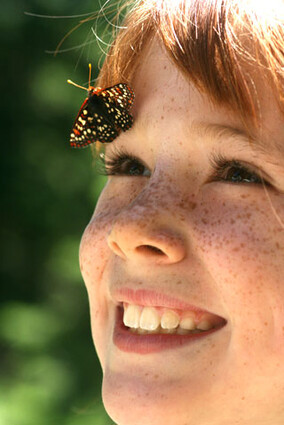Eyes on Butterflies
Last updated 7/12/2011 at Noon

Jim Anderson
Sarah Kilroy, age 9, having a close encounter with a checkerspot butterfly while helping to do the NABA Annual Metolius Butterfly Count.
Last Friday, three home-schooler families from Bend gathered at the Sisters Ranger District parking lot at 9 a.m., where they met up with me and my wife, Sue. The occasion was the Annual North American Butterfly Association (NABA) Fourth of July Metolius Butterfly Count.
For 25 years, Sue has been taking people (mostly families) on two official counts in early summer. The first one goes over to the Ochocos on the last Saturday in June, where the counters spend the day looking for butterflies all around Big Summit Prairie. The next count takes place on the second Friday in July, and covers a 15-mile-diameter circle that includes Green Ridge, Prairie Farm and other areas where butterflies can be found.
The idea behind counts of this type is to look for population trends. By conducting the survey on the same day each year, it is possible to track vital information about a butterfly that may help to fend off a disaster for the species or trigger a closer examination of its habitat, as butterflies are sensitive indicators of environmental changes.
Everyone on the count - especially the children - had a grand time, whether they were expert or novice in finding, identifying and counting butterflies. In addition to teaching the participants how to identify butterflies, everyone was also informed about the use of nets to capture the elusive insects without damaging them.
While NABA encourages the use of binoculars to identify butterflies to get away from the use of nets used by collectors, nets are used carefully at times so the butterfly can be looked at closely to ensure a positive identification.
At one stop, when I was concentrating on photographing a beautiful, tiny blue butterfly that Sue needed to have documented, I had to get down on my knees to capture the image while the insect was sipping nectar from the flower it was perched on. As I stood up, one of the children said, "Oh, Jim. You have an ant crawling on your pants leg."
Without hesitation, one of the sharp home-schoolers started laughing, and said, "Oh, Jim! You have ants in your pants!" Which brought on laughter from the whole crowd, and the loudest from me.
Everyone was focused on butterflies as the group stopped at various springs, seeps, wildflower meadows and well-known spreading dogbane wildflower sites, where diverse butterflies were found in abundance. Then it was time for a lunch stop at Prairie Farm. The reservoir there is almost full, and the splitrail fence erected around the placid water is working well at stopping the destructive "mud-boggers" from tearing up the wetlands.
After lunch, the children went looking for butterflies and found several feeding in the mud along the shoreline. They also discovered the polliwogs, and the garter snakes hanging around eating them. Thanks to the fencing, the reservoir was pristine, which gave the children the opportunity to see the rich diversity of invertebrates, reptiles, and amphibians living in the clean water.
At the end of the day, 43 species of butterflies were listed, with a total of 940 individuals. All day long the children and adults enjoyed their time in an outdoor classroom, discovering, learning and enjoying all that nature has to offer in the Sisters Country.
If you would like to become part of the annual butterfly counts, mark your calendar for next year, and
either call Sue at 541-388-1659, or send her an email: [email protected]
















Reader Comments(0)